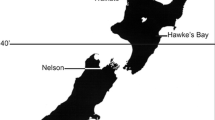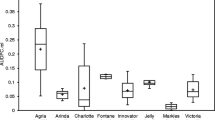Summary
In 1985 and 1986 plots were planted with seed tubers affected with black dot and with healthy seed inoculated or not with cultures ofColletotrichum coccodes at planting. Half the plots were irrigated from shoot emergence to the end of July.
Seed tubers rotted more often when they were diseased than when they were not and rotting was increased by irrigation; by contrast, up to 18 weeks after planting irrigation decreased infection of stem-bases, roots and tubers. Tuber infection, first recorded in July, increased throughout the season and most rapidly from September, when the irrigation applied earlier increased disease. Soil-applied inoculum gave most disease in both years and tubers from healthy seed gave least in 1986 but as much as from diseased seed in 1985.
Incidence and severity of black dot increased more during storage at 15°C than at 5°C and only on unwashed tubers.
Similar content being viewed by others
References
Adams, M. J., P. J. Read, D. H. Lapwood, G. R. Cayley & G. A. Hide, 1987. The effect of irrigation on powdery scab and other tuber diseases of potatoes.Annals of Applied Biology 110: 287–294.
Blakeman, J. P. & D. Hornby, 1966. The persistence ofColletotrichum coccodes andMycosphaerella ligulicola in soil, with special reference to sclerotia and conidia.Transactions of the British Mycological Society 49: 227–240.
Dickson, B. T., 1976. The ‘black dot’ disease of potato.Phytopathology 16: 23–40.
Farley, J. D., 1976. Survival ofColletotrichum coccodes in soil.Phytopathology 66: 640–641.
Hornby, D., 1968. Studies onColletotrichum coccodes. III. Some properties of the fungus in soil and in tomato roots.Transactions of the British Mycological Society, 51: 541–553.
Hunger, R. M. & G. A. McIntyre, 1979. Occurrence, development and losses associated with silver scurf and black dot on Colorado potatoes.American Potato Journal 56: 289–306.
Jellis, G. J., 1972. Silver scurf disease of potatoes. Ph.D. Thesis, University of Manchester.
Jellis, G. J. & G. S. Taylor, 1974. The relative importance of silver scurf and black dot: two disfiguring diseases of potato tubers.ADAS Quarterly Review 14:53–61.
Komm, D. A. & W. R. Stevenson, 1978. Tuber-borne infection ofSolanum tuberosum ‘superior’ byColletotrichum coccodes.Plant Disease Reporter 62: 682–687.
Langerfeld, E., 1985.Colletotrichum coccodes (Wallr.) Hughes, ein nicht genügend beachteter Erreger von Schäden an Kartoffeln.Nachrichtenblatt des Deutschen Pflanzenschutzdienstes 37: 49–53.
McIntyre, G. A. & C. Rusanowski, 1975. Scanning electron microscope observations of the development of sporophores ofColletotrichum atramentarium (B. et Br.) Taub. on infected potato periderm.American Potato Journal 52: 269–275.
Meijers, C. P., 1975. Invloed van de bewaarcondities op de aantasting van aardappelen door micro-organismen.Landbouwkundig Tijdschrift 87: 147–153.
Mooi, J. C., 1955. Knolaantasting bij enige aardappelrassen doorColletotrichum atramentarium (Berk. et Br.) Taub.Tijdschrift over Plantenziekten 61: 22–23.
Mooi, J. C., 1959. A skin necrosis occurring on potato tubers affected by black dot (Colletotrichum atramentarium) after exposure to low temperatures.European Potato Journal 2: 58–68.
Moore, W. C., 1959. British Parasitic Fungi, Cambridge University Press, Cambridge, England.
Otazu, V., N. C. Gudmestad & R. T. Zink, 1978. The role ofColletotrichum atramentarium (B. et Br.) Taub. an Kartoffelstauden (Solanum tuberosum L.).Phytopathologische Zeitschrift 26: 1–30.
Stevenson, W. R., R. J. Green & G. B. Bergeson, 1976. Occurrence and control of potato black dot root rot in Indiana.Plant Disease Reporter 60: 248–251.
Thirumalachar, M. S., 1967. Pathogenicity ofColletotrichum atramentarium on some potato varieties.American Potato Journal 44: 241–244.
Author information
Authors and Affiliations
Rights and permissions
About this article
Cite this article
Read, P.J., Hide, G.A. Effects of inoculum source and irrigation on black dot disease of potatoes (Colletotrichum coccodes (Wallr.) Hughes) and its development during storage. Potato Res 31, 493–500 (1988). https://doi.org/10.1007/BF02357887
Accepted:
Issue Date:
DOI: https://doi.org/10.1007/BF02357887




